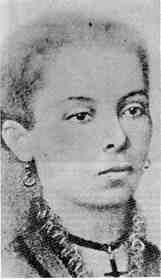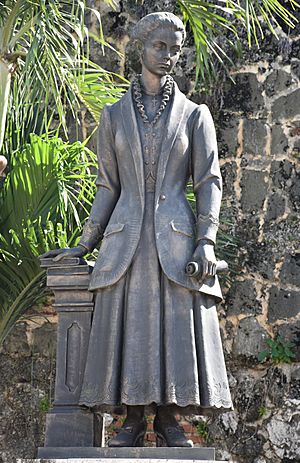Salomé Ureña facts for kids
Quick facts for kids
Salomé Ureña
|
|
|---|---|
 |
|
| Born |
Salomé Ureña Díaz
October 21, 1850 Santo Domingo, Dominican Republic |
| Died | March 6, 1897 (46 years old) Santo Domingo, Dominican Republic |
| Resting place | National Pantheon of the Dominican Republic |
| Occupation | Writer • Pedagogy |
| Years active | 1867-1881 |
| Spouse(s) | Francisco Henríquez y Carvajal |
| Children | Francisco Noel Henríquez Ureña, Pedro Henríquez Ureña, Maximiliano Henríquez Ureña, Camila Salomé Henríquez Ureña |
Salomé Ureña Díaz de Henríquez (born October 21, 1850 – died March 6, 1897) was an important Dominican poet and teacher. She was a key figure in 19th-century poetry. Salomé Ureña also strongly supported education for girls and women in the Dominican Republic.
She was inspired by new teaching ideas, especially from Eugenio María de Hostos. Her poems often focused on love for her country and family life. Even though she didn't write a huge number of poems, her deep and meaningful works caught the attention of many people across Latin America. Some of her famous poems include Offering to the Homeland, The bird and the nest, and To my mother.
Early Life
Salomé Ureña was born in Santo Domingo, Dominican Republic, on October 21, 1850. Her parents were Nicolás Ureña de Mendoza and Gregoria Díaz de León. Her father was a writer, politician, and journalist.
Even though her parents separated, Salomé had a very close relationship with her father. He played a big part in her learning and character. Salomé learned to read with her mother when she was just four years old. This shows how much her parents cared about her education.
She went to elementary schools, but her main learning as a teenager came from her father. He taught her a lot about literature. Salomé learned poems from her father's favorite writers. She also studied classic Spanish, English, and French literature.
Becoming a Writer
Salomé started writing poems when she was fifteen years old. She published her first works at age seventeen. These early poems were known for being natural and gentle.
In 1867, she first published her works using the pen name "Herminia." She continued to use this name until 1874.
On February 11, 1880, when she was 29, she married Francisco Henríquez y Carvajal. He was a doctor, writer, and later became president of the Dominican Republic. They had four children: Francisco, Pedro, Max, and Camila. Her children later became well-known writers, thinkers, and artists.
Helping Education
Around 1881, Salomé Ureña opened one of the first higher education centers for young women in the Dominican Republic. She started this school with help from her husband. She named it "Instituto de Señoritas" (Institute for Young Ladies).
Just five years later, the first six female teachers graduated from her Institute. This was a very unusual and important achievement at that time. The first graduates included Mercedes Laura Aguiar and Luisa Ozema Pellerano.
Her Legacy
In 1874, at age 23, Salomé helped publish a collection of poems by writers of her time. This book was called "La Lira de Quisqueya." It came out about a year after a harsh government was overthrown. The book included seven of Salomé's poems, such as The Glory of Progress and My Homeland.
As time went on, her poems sometimes became sad, like In hours of anguish. Other times, they were strong and patriotic, like A la Patria (To the Homeland) and Ruinas (Ruins). In her later years, she wrote about her own life in her poems. For example, Mi Pedro was a very loving poem dedicated to her son. She also wrote The Arrival of Winter and a popular book called Esteban, which talked about her country, family, plants, and flowers.
Death
Salomé Ureña passed away on March 6, 1897, at the age of 46. She died from complications of tuberculosis. She was first buried in the Church of Nuestra Señora de las Mercedes. Later, in 1972, her remains were moved to the National Pantheon of the Homeland.
See also
 In Spanish: Salomé Ureña para niños
In Spanish: Salomé Ureña para niños



